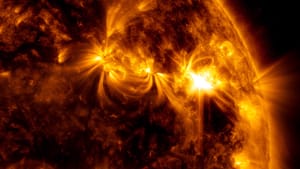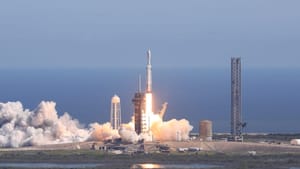
Aug 3, 2024
Radiation on Our Interplanetary Journeys
Polaris Dawn is coming up and will take humans farther than we have been since 1972, when Apollo 17, the last crewed mission to the Moon, took place. Now the Polaris Dawn crew will travel to an apogee of ~1,400 km on a 5-day journey where they too will face the dangers of space. They will experiment with and encounter higher levels of radiation than what the astronauts on the ISS experience, an already significant amount.
This precious research and knowledge will be used for future interplanetary missions like the great journey to our red neighboring planet and when we build a base on the Moon, but how will these future missions deal with the intense radiation of space and what measures are already being taken to shield astronauts from these hazards?
Origins
If you've ever seen images of the Sun's photosphere, that is, the surface of the Sun, you have probably seen the effects of solar flares. These are large coronal mass ejections reaching as long as a quarter of the way to Earth, or about 0.25 AU.
The cause is due to the twisting of magnetic field structures in the Sun's lower corona. At some point, typically around the peak of solar activity when the Sun's magnetic field flips, the structures realign with other magnetic field structures. This is called magnetic reconnection and causes the reconnected masses to create a loop that breaks and shoots the upper part away from the Sun.

Inside the Sun's core, hydrogen is fused into helium. During this process, the protium isotope of hydrogen fuses with another protium isotope to create a deuterium isotope. The deuterium isotope fuses with one more protium isotope to create helium-3, and during this process, gamma-radiation is released as a result of leftover mass from the reaction.
The charged particles and their radiation are constantly emitted from the Sun and in some cases, focused in the direction of the coronal mass ejection, causing solar storms that occasionally hit Earth, knocking out power grids and satellites.
Another type of radiation, alpha radiation (α), is released from the Sun's corona when electrons in the coronas plasma gather sufficient speeds to boost helium nuclei to escape velocities of over 600 km/s. The helium nuclei (alpha particles) then reach the Earth's magnetosphere where they're trapped.
The Earth's magnetosphere consists of two main radiation belts called the inner- and outer Van Allen belts which extend to an altitude of about 58,000 km.

Because the Earth's equatorial plane is inclined at a 23.5° angle relative to the ecliptic plane and the Moon's orbital inclination is 5.1°, Apollo missions only spent 52 minutes in the belts as they flew through the thinner part of the outer belt. This exposure is only about 13 rad, well below the harmful dose of 100 rad.
A lesser but similar inclination can be flown when going to Mars, making the time spent in the Van Allen belts short for Mars trajectories as well.
Interplanetary Radiation
The real danger arises once the spacecraft has to spend a long time in space. In the German-American rocket scientist Werner Von Braun's specification on a journey to Mars, The Mars Project, one of the few shortcomings of the book was the effects of radiation exposure on humans. Although staying in space for long periods is nothing new to us, on interplanetary missions the spacecraft has no magnetosphere or atmosphere to protect it like the ISS has, but that doesn't mean similar technologies used on the ISS can't be used here.
In places such as the sleeping quarters on the ISS, where the astronauts spend a significant amount of time, hydrogen-rich shielding such as polyethylene is used because of its low density. This may seem counter-intuitive, as high-density materials such as lead and concrete are often regarded as being the most effective blockers of radiation, and while that is true, they also create more secondaries.
Secondaries arise when the radiation and the material it hits interact, creating particles such as ions, electrons, photons, and neutrons, a secondary radiation particle, hence the name. A heavier and more dense material has a higher probability of interacting with the particles hitting it, and the secondaries can actually be worse for the astronauts' health than the primary radiation.
A lightweight polyethylene, RFX1, has shown 50% better shielding against the incoming radiation from solar flares compared to aluminum. The shielding material needs to be light but thick enough to stop the primary radiation. This thickness will add a lot of "dead mass" to the spacecraft, thereby limiting the payload and fuel capacity and increasing nightmare fuel for an aerospace engineer.
Magnetic Shielding
Another proposed option is for the spacecraft to create its own little magnetosphere to protect against the high energy galactic cosmic- and solar rays. In this technology, a high current is passed through some coils to create strong magnetic fields, but this one has drawbacks too.
Calculations have shown that around 20 tesla are needed to create these strong magnetic fields, and for that, you need a high current. To create a high current, you need a lot of power from what will presumably be solar panels, and you need to cryo-cool the superconductors to limit the vibrations of the atoms inside the coils.
Although SpaceX's Starship already uses cryogenic methane and oxygen, a whole new system across a good chunk of Starship's surface needs to be implemented, adding a lot of "dead mass".
Another problem is the concern for the astronauts' health. Most MRI scanners only operate at 1,5 or 3 Tesla and on the surface of the Earth we only feel about 0.00005 Tesla so you can imagine 20 Tesla constantly bombarding the astronauts' body for 9 months is suboptimal.
Electrostatic Shielding
Electrostatic shielding can work by using Van De Graaf generators to create high electric potential across the surface of the spacecraft. When protons from galactic cosmic rays or alpha particles hit the spacecraft, they're deflected by the electric field. This method is far lighter and less complex, but it is still unclear how effective it is, as higher currents than are currently possible with this setup may be needed.
Dietary Countermeasures
A great deal of research has also been put into how our bodies can protect against radiation instead of relying on hydrogen-rich shielding, electrostatic shielding, and sunscreen.
Nutrients like vitamins A and C have been shown to remove radiation-produced free-radicals that can change DNA and damage cells, ultimately leading to cancer or tumors. Specific diaries have also been shown to have a positive effect on protection against radiation.
Another method is the use of drugs and medication. Radioprotectants can stimulate the growth of stem cells. Unspecialized stem cells can divide into specialized stem cells in a process called differentiation, and the specialized stem cells can then repair the radiation-damaged DNA and cells.
Conclusion
Taking all of this into account shows, that one single method probably won't do the job, as of now, and the spacecraft will have to merge different systems. It could consist of electrostatic shielding combined with a relatively thin layer of light polyethylene in frequently occupied areas of the spacecraft, and a good diet containing some amount of radioprotectants.
There could also be some sort of supermaterial in development, with the ability to absorb all incoming cosmic and solar rays without creating secondaries, but we simply don't know yet.
The future will be an amazing sight to see, and it has already started.



